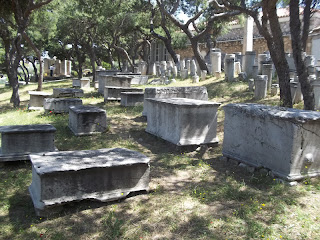Today was our
last day in Athens, and we spent it arranging for our trip to Venice, a day
earlier than planned; visiting the Greek Agora, including the prison where
Socrates died and the Hephaistion; the Stoa Museum; the Keramikos, an ancient
cemetery; and the National Archaeological Museum, which is one of the best
museums in the world.
Due to the
Greek Labour Day holiday tomorrow, and a general strike that is advertised all
over town – we have elected to move on to Venice a day earlier. Our original plan, to visit Mycenae
and Epidaurus,
has been cancelled, as no archaeological sites will be open, and there are no
guarantees that busses and trains will be running. Therefore, we packed more into our last day
in Athens than even we thought possible, especially
since the travel arrangements took up an hour of our precious “open
archaeological site time”, and mailing the many pounds of guide books back to Canada took
another hour. (Although I must say that
hanging onto the bag of books for an hour made me more reconciled to the cost
of sending them home early, as Ian suggested.)
Refreshed
with a gelato, we headed toward the Agora.
It was a real pleasure to be able to explore the Greek Agora at leisure
and without an agenda, and we saw lots that we hadn’t seen before. We visited the small Byzantine Church
again, and discovered that more 11th century frescoes have been
added to the originals, these from another small church that was irreparably
damaged in the 1999 earthquake.
We were
surprised and delighted to find the Stoa
Museum open, in spite of
the posted closure. It gives a good
sampling of the different artefacts that were found in the area of the agora
itself.
It was also a
pleasure to see our favourite temple, the Hephaistion, looking as eternal and
beautiful as ever.
We decided to
look for the Bouelion, since I had ruined Ian’s movie about the Theatre of
Dionysius by saying, “No! It’s the
Bouelion,” and Ian had to prove how wrong I was.
Although we only found a pile of indeterminate ruins, we walked the entire perimeter of the park, and found the ancient city prison, where Socrates died. There was something remarkable about standing in the place where such an important historical event took place.
Although we only found a pile of indeterminate ruins, we walked the entire perimeter of the park, and found the ancient city prison, where Socrates died. There was something remarkable about standing in the place where such an important historical event took place.
After an iced
coffee, and some debate over the map, we went to the Keremios, which is not
only the area where the ceramics artists worked, but was also the place for
very high class funerary monuments.
They have
wisely moved the most important funerary monuments to museums – the site’s
museum really was closed today -- but they have put replicas in their places,
and one gets a sense of things. The park
is at the intersection of several important ancient roads: the road to Piraeus, once flanked by the walls of
Themistocles, and having the funerary monuments of many famous Athenian
families, such as the Alcibiades clan; the Sacred Way, which culminates in the
Acropolis; and the road to the Lyceum of Plato.
They have
done a really good job making both parks natural and beautiful. Yes, you can hear sirens and traffic from the
city that surrounds each park, and yes, there are constant whistles from the
security guards sitting in every patch of shade, but there is still plenty of
“scope for the imagination”, as Anne of Green Gables would say.
We stayed
until the site closed at 3:00. I wanted
to take the subway to the Archeological
Museum, and Ian thought
we could walk it more quickly, so we compromised and walked there: it took 45 minutes. It was open until 8:00 this evening, but we
only made it until 7:30, when our brains switched over to severe overload
status and our legs ached liked they hadn’t done since the first few days of
our tour. However, we did see every
single room that was open, and saw so many amazing things that I don’t know how
to explain them all! Highlights include
the cache of weapons retrieved from Thermopylae, where the 300 Spartans made
their stand against the Persians; the artefacts from Akrotiri, removed from
Santorini when the roof collapsed and not returned quite yet; the mask of
“Agamemnon” and other treasures from Mycenae; the Cycladic figures; the
amazing, astounding, perfectly beautiful sculptures, and I’m sure Ian has his
own list.





























No comments:
Post a Comment